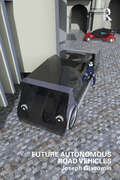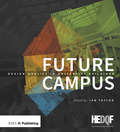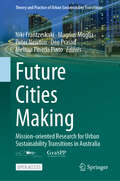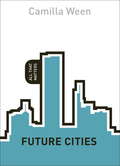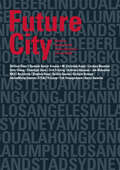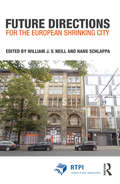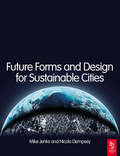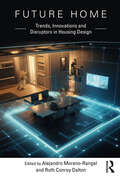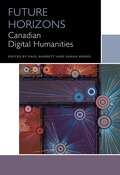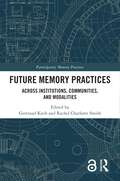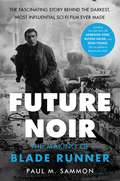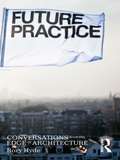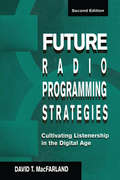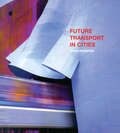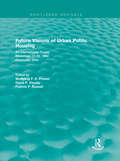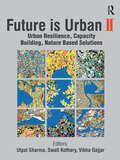- Table View
- List View
Future Access Enablers for Ubiquitous and Intelligent Infrastructures: Third International Conference, Fabulous 2017, Bucharest, Romania, October 12-14, 2017, Proceedings (Lecture Notes of the Institute for Computer Sciences, Social Informatics and Telecommunications Engineering #241)
by Octavian Fratu Nicolae Militaru Simona HalungaThis book constitutes the refereed post-conference proceedings of the Third International Conference on Future Access Enablers for Ubiquitous and Intelligent Infrastructures, FABULOUS 2017, held in Bucharest, Romania, in October 2017. The 37 revised full papers were carefully reviewed and selected from 61 submissions. The main topics deal with future access networks, Internet of Things and smart city/smart environment applications, communications and computing infrastructures, security aspects in communication and data processing, signal processing and multimedia.
Future Autonomous Road Vehicles
by Joseph GiacominThis book provides a comprehensive overview of the past, present and future of autonomous road vehicles for professionals and students.Split into three parts, the first section of the book brings together the key historical developments in autonomous road vehicle design and the primary explorations of the design possibilities from science fiction. This historical analysis draws upon significant test vehicles from history and explores their roles as landmarks in the evolution of the field. In addition, it also reviews the history of science fiction and outlines the key speculations about autonomous road vehicles which emerged from that world. In the second section of the book, Joseph Giacomin introduces five of the most popular future-facing speculative approaches used by designers. In doing so, he identifies the major user-facing challenges which affect ideation, product design, service design and business modelling. In the final part, science fiction prototyping is identified as the speculative approach best suited to autonomous road vehicle application. Connecting theory with practice, Giacomin provides examples of sixteen science fiction prototypes, which cover a comprehensive range of physical, psychological, sociological and ethical design challenges.Written as an accessible guide for design practitioners and students, this book will be of use to those interested in the psychological, sociological and ethical factors involved in automotive design, human-centred design, industrial design and technology.
Future Campus
by Ian TaylorThis book is to help architects, design teams and University clients (estates departments, and academics) in their pursuit of practical and innovative solutions for the creation of enabling higher education learning environments. It includes abundant examples of solutions to design problems and advice on best practice. This book argues that investment in the higher education sector is a driver for intellectual, social and economic development, offering opportunities for positive impacts for the physical environment on the character and performance of higher education. The editor believes that good outcomes result from good design, which should address elements such as learning from best current practice, the importance of clear briefing, good environmental performance, the positive social impacts and, also, the importance of ensuring a beautiful outcome. It has chapters contributed from leading-edge practices, including case studies with highly illustrated project examples. All this is underpinned by an understanding of the practicalities of working in the sector as well as the socio-political and economic context and trends shaping future practice.
Future Cities Making: Mission-oriented Research for Urban Sustainability Transitions in Australia (Theory and Practice of Urban Sustainability Transitions)
by Niki Frantzeskaki Peter Newton Deo Prasad Magnus Moglia Melissa Pineda PintoThis open access book describes the complex dynamics that coevolve in cities and from cities, to inform agendas for urban research and urban policy with a view to future city missions. It provides a suite of research-informed chapters on urban pathways that are early signals and visions for how future cities can be shaped and transformed as well as chapters from policy, industry and intermediary organization actors that relate and respond to these pathways from a mainstreaming and implementation perspective. This edited collection intends to trigger and capture an ambitious transformative agenda amongst researchers and practitioners who have as their mission to shape urban futures. While there is proliferating literature on cities, urbanism and urban governance, this book offers a unique selling point – implying a research positioning point – to the field of sustainability transitions by intersecting research on urban sustainability transitions and missions-oriented research. The focus on the nexus of game-changers, pathways and innovations sets the book firmly in the leading edge of urban transitions research. The book engages with a breadth of disciplines including sustainability science, urban planning, urban design, mobility, energy, climate change science, urban ecology, urban sociology, architecture, data science, sustainability transitions studies, policy analysis and policy studies, as well as environmental governance. As an output, it aims to engage with and inspire future research and teaching/education in the fields of architecture and urban planning, urban design, environmental governance, sustainability science, innovation studies and urban sociology.
Future Cities: All That Matters (All That Matters Ser.)
by Camilla WeenIn Future Cities: All that Matters Camilla Ween will outline the challenges of meeting the anticipated growth of world cities over the next few decades. By 2030 it is predicted that between 80-90 % of the world's population will be living in cities, in several countries this will be 100%; Singapore is already classified as having a 100% urban population. There will be many cities with populations of over 20 million. The infrastructure required to support these cities will be a massive challenge for city planners and governments. Never in the history of civilisation has the need to deliver so much been so urgent - and with dwindling world resources. Tackling the challenges will be further complicated by pressure to develop solutions that are sustainable and include climate change mitigation measures. Some advocate geo-engineering - the large-scale engineering and manipulation of the world's environment e.g. ocean fertilisation to remove CO2 from the atmosphere, as the answer to tackling climate change. Others see this as a doomsday scenario and believe the solution lies in behaviour adaptation, changing the way we live and making do with less. Despite the difficulties, the book will chart how some cities are already tackling the problems, policies that are emerging to meet these challenges and will highlight innovations that are currently being explored.
Future Cities: All That Matters (All That Matters)
by Camilla WeenIn Future Cities: All that Matters Camilla Ween will outline the challenges of meeting the anticipated growth of world cities over the next few decades. By 2030 it is predicted that between 80-90 % of the world's population will be living in cities, in several countries this will be 100%; Singapore is already classified as having a 100% urban population. There will be many cities with populations of over 20 million. The infrastructure required to support these cities will be a massive challenge for city planners and governments. Never in the history of civilisation has the need to deliver so much been so urgent - and with dwindling world resources. Tackling the challenges will be further complicated by pressure to develop solutions that are sustainable and include climate change mitigation measures. Some advocate geo-engineering - the large-scale engineering and manipulation of the world's environment e.g. ocean fertilisation to remove CO2 from the atmosphere, as the answer to tackling climate change. Others see this as a doomsday scenario and believe the solution lies in behaviour adaptation, changing the way we live and making do with less. Despite the difficulties, the book will chart how some cities are already tackling the problems, policies that are emerging to meet these challenges and will highlight innovations that are currently being explored.
Future City
by Stephen Read Job Van Eldijk JürgenThis text focuses on cities as the dominant form of human settlement for the future, examining the transformation that is happening in urban connobations worldwide today. The last few decades have seen a rate of change and growth in cities that has never been seen before, resulting in giant metropoles with over twenty million inhabitants. This book tackles the causes of these changes, and looks at how the planning and design of cities can shape the urban future.
Future Directions for the European Shrinking City (RTPI Library Series)
by William J.V. Neill Hans SchlappaUrban shrinkage is rising to the top of the political agenda in Europe as more cities are shrinking in the prolonged economic downturn we encounter. Coupled with unprecedented budgetary austerity and rapidly ageing populations, ‘stagnating’ and ‘shrinking’ cities have emerged as a key challenge for policy and practice for decades to come. Local actors need to find new ways of collaborating across sectors, agencies and disciplines to unlock opportunities for interventions that mitigate the worst effects of urban shrinkage and long-term decline. Future Directions for the European Shrinking City focuses on policy and planning interventions that can be taken by municipalities and their local stakeholders to tackle stagnation and decline. With case studies from a range of European countries this book proposes ways to tackle shrinkage through governance, policy, planning, social, economic and management interventions. Edited by William J.V. Neill and Hans Schlappa, this book is ideally suited for policy makers and practitioners in urban planning, regeneration, and economic development dealing with pressing spatial and socio-economic issues on a European scale.
Future Directions in Energy Engineering: Challenges, Opportunities, and Sustainability (Green Energy and Technology)
by Xiaolin WangFuture Directions in Energy Engineering: Challenges, Opportunities, and Sustainability presents new advances and research results in theoretical, experimental, and practical sustainable energy engineering. Contributions cover case studies to explore and analyze technological advancements alongside practical applications to help readers better understand the relevant concepts and solutions necessary to achieve clean energy and sustainable development. The book brings together the latest developments in the emerging areas of intelligent power systems, green energy, and technology. Coverage includes: Electric power generation, transmission, and distribution; Power system economics, operation, and control; Energy storage and cybersecurity for smart grids; Energy efficiency in building designs and management; Sustainable materials for buildings; Integration of renewable energy sources in buildings; Greening urbanization and urban settlements. The book offers approaches to help engineers and researchers in sustainable energy engineering technologies solve practical problems affecting their daily work.
Future Forms and Design For Sustainable Cities
by Mike Jenks Nicola DempseyConcentrating on the planning and design of cities, the three sections take a logical route through the discussion from the broad considerations at regional and city scale, to the larger city at high and lower densities through to design considerations on the smaller block scale. Key design issues such as access to facilities, access for sunlight, life cycle analyses, and the impact of communications on urban design are tackled, and in conclusion, the research is compared to large scale design examples that have been proposed and/or implemented over the past decade to give a vision for the future that might be achievable.
Future Healthcare Design
by Sumita SinghaThis book describes how architects can design better healthcare buildings for a rapidly changing context and climate. Innovation in the design of healthcare estates is essential to the sustainability of our health services. Design thinking in this field is being influenced by a range of factors, such as economic constraints, an ageing demographic, complex health conditions (co-morbidities), and climate change. There is an opportunity for architects and designers to be innovators in the future of healthcare through the design of buildings and cities that offer wellbeing and healing. It highlights the latest innovations in key areas of practice and research, with a range of case studies to provide practical lessons and inspire better design.
Future Home: Trends, Innovations and Disruptors in Housing Design
by Ruth Conroy Dalton Alejandro Moreno-RangelGlobal pandemics, smart technologies, demographics and climate change are just some of the external disruptors that may impact the home’s evolution over the next ten years. Future Home provides a comprehensive ‘horizon scan’ of what our homes may be like approximately ten years from now, by looking for early signs of potentially important developments through a systematic examination of trends, innovations and disruptors. The authors consider what aspects of the home are likely to remain constant and what aspects may change beyond all recognition and if changes are predicted, what form they may take and, most importantly, what this means for design professionals. Exploring areas of buildings and technology, people and delivery, each chapter addresses the catalysts, natures and responses to these changes. This book provides an overview of the future home that will be essential reading for designers, policy-makers and homeowners alike.
Future Horizons: Canadian Digital Humanities (Canadian Literature Collection)
by Susan Brown Gregory Betts Dean Irvine Sandra Djwa Constance Crompton Katherine McLeod Klara Du Plessis Kiera Obbard Roopika Risam Andrea Zeffiro Deanna Fong M Ryan Fitzpatrick M Eric Schmaltz Dani Spinosa M David Gaertner M Mark V. Campbell M Jon Saklofske Julia Polyck-O’Neill Kim Martin Rashmeet Kaur Pascale Dangoisse Michelle Schwartz Graham H. Jensen M Allan Cho Sarah Zhang Kendra Cowley Asen IvanovAu fil des vingt et quelques chapitres que compte cet ouvrage, les auteurs explorent le passé, le présent et l’avenir de la recherche, de l’enseignement et de l’expérimentation en sciences humaines numériques au Canada. Ce recueil, qui rassemble les travaux de chercheuses et de chercheurs établis et émergents, présente des initiatives contemporaines dans le domaine des sciences humaines numériques. Celles-ci sont conjuguées à un réexamen de l’héritage légué par ce domaine jusqu’à ce jour et à des discussions sur son potentiel. Future Horizons jette aussi un regard historique sur des projets numériques d’envergure, quoique largement méconnus, qui ont été réalisés au Canada. Future Horizons fait plonger le lecteur dans des projets qui mettent à contribution une vaste gamme d’approches — des jeux numériques aux laboratoires ouverts, des archives sonores à la poésie numérique, des arts visuels à l’analyse textuelle numérique — et qui puisent dans des matériaux canadiens tant historiques que contemporains. Dans leurs essais, les auteurs font voir comment une telle diversité d’approches remet en cause la connaissance en permettant aux chercheurs de poser de nouvelles questions.Ce recueil remet en question l’idée selon laquelle il n’existerait qu’une seule définition des sciences humaines numériques ou une seule identité collective nationale. En observant les interactions du numérique avec la race, l’autochtonie, le genre et la sexualité — sans oublier l’histoire, la poésie et le concept de nation —, Future Horizons propose une vue élargie du travail à l’intersection des sciences humaines numériques et des sciences humaines traditionnelles dans le Canada d’aujourd’hui. Ce livre est publié en anglais.Formats disponibles : couverture souple, PDF accessible et ePub accessible.
Future Libraries (Representations Books #7)
by R. Howard Bloch Carla HesseThis title is part of UC Press's Voices Revived program, which commemorates University of California Press’s mission to seek out and cultivate the brightest minds and give them voice, reach, and impact. Drawing on a backlist dating to 1893, Voices Revived makes high-quality, peer-reviewed scholarship accessible once again using print-on-demand technology. This title was originally published in 1993.
Future Memory Practices: Across Institutions, Communities, and Modalities (Participatory Memory Practices)
by Rachel Charlotte Smith Gertraud KochFuture Memory Work addresses a crucial challenge in contemporary pluralistic societies: the organisation of open, participatory and socially inclusive memory practices in digital media ecologies. It brings a novel relational approach to future memory work across institutions, people, and modalities.Advancing inter- and transdisciplinary research and rich empirical cases from across Europe and beyond, the book examines how memory practices in digital media are open for engagement of people with diverse backgrounds. It analyses the modalities of memory making and how they can enable institutional and public memory making with a broad spectrum of people and groups in civil society at local, translocal, national and global levels. The chapters examine the mediatized character of memory making, whilst also critically considering what obstacles and potentials emerge from participatory memory work. As a whole, the book is a comprehensive source of knowledge and ideas for creating socially inclusive, sustainable memory practices and futures. It sets the multidisciplinary research agenda for advancing studies of heritage in contemporary digital media as an element and a driver of cultural and social change.Future Memory Work is essential reading for academics, students and professionals working in the fields of Anthropology, Museum Studies, Digital Cultural Heritage, Memory Studies, Cultural Studies and Design.
Future Noir: The Making of Blade Runner
by Paul M. SammonUpdated edition: The ultimate guide to Ridley Scott’s transformative sci-fi classic Blade Runner, with photos, new cast interviews, and more.Based on Philip K. Dick’s brilliant and troubling science fiction masterpiece Do Androids Dream of Electric Sheep?, Blade Runner is among the most visually dense, thematically challenging, and influential science fiction films ever made. Future Noir offers a deeper understanding of this cinematic phenomenon that is storytelling and visual filmmaking at its best.In an intensive, intimate, and anything-but-glamorous behind-the-scenes account, Paul M. Sammon explores how Ridley Scott purposefully used his creative genius to transform the work of science fiction’s most uncompromising author into a critical sensation and cult classic that would reinvent the genre. Sammon reveals how the making of the original Blade Runner was a seven-year odyssey that would test the stamina and the imagination of writers, producers, special effects wizards, and the most innovative art directors and set designers in the industry at the time it was made. This revised and expanded edition of Future Noir includes:An overview of Blade Runner’s impact on moviemaking and popular culture An exploration of the history of Blade Runner: The Final Cut and its theatrical release in 2007A look at its long-awaited sequel, Blade Runner 2049The longest interview Harrison Ford has ever granted about Blade RunnerExclusive new interviews with Rutger Hauer and Sean YoungA fascinating look at the ever-shifting interface between commerce and art, illustrated with production photos and stills, Future Noir provides an eye-opening and enduring look at modern moviemaking, the business of Hollywood, and one of the greatest films of all time.
Future Office
by David Walters Chris GrechDevelopments in IT and the resulting knowledge-based economy have challenged traditional concepts of office design, as well as many of the larger architectural and urban design models. This book examines the implications of this revolution on current urban design and identifies potential new trends in office design from an international perspective. Six themes are addressed: IT and building infrastructure new office/new community organizational change high performance building envelopes interior environment value added sustainable design. These forward-thinking essays have been contributed by practitioners and academics from a wide spectrum of interests to deliver an illuminating look into the unfolding possibilities and challenges ahead.
Future Office: Next-generation workplace design
by Nicola GillenThe office is dead. Long live the office. Despite decades of predictions that the office is on the verge of extinction, it is surviving and thriving. Of course, things are changing. And changing fast. Digital technologies are transforming not only the work we do, but also the ways our workplaces are designed, built and operated. Automation and AI mean that some jobs will no longer exist whilst others will be created. But the very essence of the workplace — human interaction and collaboration, remains as necessary as ever. In fact, it is the human focus that is driving this new age, with four generations now in the workplace together for the first time. Taking an interdisciplinary approach, this book discusses the impacts of these changes on the future of work and workplace. The latest technologies are also explored from voice and digital twins, to new materials such as graphene and battery-powered buildings.
Future Practice: Conversations from the Edge of Architecture
by Rory HydeDesigners around the world are carving out opportunities for new kinds of engagement, new kinds of collaboration, new kinds of design outcomes, and new kinds of practice; overturning the inherited assumptions of the design professions. Seventeen conversations with practitioners from the fields of architecture, policy, activism, design, education, research, history, community engagement and more, each representing an emergent role for designers to occupy. Whether the "civic entrepreneur," the "double agent," or the "strategic designer," this book offers a diverse spectrum of approaches to design, each offering a potential future for architectural practice. With a foreword by Dan Hill and interviews with Steve Ashton, ARM; Bryan Boyer, Helsinki Design Lab; Camila Bustamante; Mel Dodd, muf_aus; DUS Architects; Jeanne Gang, Studio Gang; Reinier de Graaf and Laura Baird, AMO; Conrad Hamann; Natalie Jeremijenko, xClinic; Indy Johar, 00:/;Bruce Mau; Arjen Oosterman and Lilet Breddels, Volume; Todd Reisz; Wouter Vanstiphout, Crimson; Matt Webb, BERG; Marcus Westbury, Renew Newcastle; and Liam Young, Unknown Fields
Future Radio Programming Strategies: Cultivating Listenership in the Digital Age (Routledge Communication Series)
by David MacFarlandFundamental beliefs is what the reader will be exploring here -- a common understanding of what the radio enterprise should be about: entertainment and information. A major thrust of this book is to arrive at a set of fundamental beliefs about the values and realities of the radio business in regard to entertainment programming -- a set of beliefs that may or may not be right, true, or forever, but that might at least provide a basis for developing programming strategies. This second edition of Future Radio Programming Strategies seeks to answer the question: "What do listeners really want from radio?" Some of the answers are derived from "users-and-gratifications" research in the mass media. Instead of focusing on what mass media do to people, the users-and-gratifications perspective seeks to discover what people do with mass media. The functionalist viewpoint of such research basically says that a medium is best defined by how people use it. Having looked at some of the audience research that comes from sources other than the standard ratings companies, the book then goes on to demonstrate new ways that formats, production procedures, and announcing styles can meet audience needs and desires. Although the volume concludes with several original methods for selecting and presenting airplay music based on the audience's moods and emotional needs, it does not insist upon a singular, formulaic approach for constructing or modifying a music format. Instead, it attempts to involve the reader in thinking through the process of format development. Two audio tapes are also available for use with the book. The tapes contain nearly 3 hours of important, detailed information and provocative points from the book. Exclusive audio examples include: * the sense of acoustic space in music; * hi-fi versus lo-fi listening environments; * subjective perception of the announcer's distance from the listener; * audio editing rates; * comparison of luxury versus inexpensive car listening experiences; and * the components of emotions that are expressed vocally. The tapes also include new sections about the threats to traditional radio from specialized digital audio services, competition for the listener's attention from computer-based media, and additional proof of how music can be chosen on the basis of listeners' emotional reactions and mood needs.
Future Schools: Innovative Design for Existing and New Buildings
by Sharon Wright Nick MirchandaniUniquely Future Schools not only provides design guidance on themes in schools architecture and a wealth of recent innovative projects drawn from the UK but also an understanding of the socio-political and economic context that any practice must work within when taking on a schools project. It balances beautiful visuals and innovative case studies with in-depth discussion of the thought processes and issues to consider in good school design. Reflecting on ambitious projects during the BSF period of high investment and post-BSF creativity and innovation during austerity it considers the next phase of school design shaped by growing student numbers, diversity in project types and routes and the growing opportunities for smaller practices as work on existing buildings becomes more common.
Future Stories in the Global Heritage Industry (Routledge Studies in Heritage)
by Alia Yunis Robert Parthesius NiccolòAcram CappellettoFuture Stories in the Global Heritage Industry explores what happens to the heritage and memory of communities that find themselves in contact with the rest of the world when they become UNESCO World Heritage Sites.Written by an interdisciplinary group of emerging scholars and heritage professionals connected to these sites through their own heritage, this volume considers how a community can engage with a site’s globalized importance while retaining its own sense of history. Drawing on oral histories, ethnographic methods, film, interviews, and archival research, the book adds to the discourse around Critical Heritage Studies. It does so by putting theories into practice in selected heritage sites in Romania, the UAE/India, Eritrea, China, Mozambique, Tanzania, and Malaysia. The book also contributes toward the dismantlement of the many dichotomies imposed on heritage from the divisions between natural and cultural, or tangible and intangible in the UNESCO Conventions and Eurocentric heritage practices. Looking toward the future of the past, the volume asks whether heritage can be objectively or equitably managed, as it increasingly comes into conflict with issues around nation‑building, climate change, social class, ethnicity, religion, and gender.Future Stories in the Global Heritage Industry will be of great interest to academics and students engaged in the study of heritage, sociology, public history, history, international studies, sociology, and anthropology.
Future Transport in Cities
by Brian RichardsCities around the world are being wrecked by the ever-increasing burden of traffic. A significant part of the problem is the enduring popularity of the private car - still an attractive and convenient option to many, who turn a blind eye to the environmental and public health impact. Public transport has always seemed to take second place to the car, and yet alternative ways of moving around cities are possible. Measures to improve public transport, as well as initiatives to encourage walking and cycling, have been introduced in many large cities to decrease car use, or at least persuade people to use their cars in different ways.This book explores many of the measures being tried. It takes the best examples from around the world, and illustrates the work of those architects and urban planners who have produced some of the most significant models of "transport architecture" and city planning. The book examines the ways in which new systems are evolving, and how these are being integrated into the urban environment. It suggests a future where it could be mandatory to provide systems of horizontal movement within large-scale development, using the analogy of the lift, upon which every high-rise building depends. In so doing, future cities could evolve without dependence on the private car.
Future Visions of Urban Public Housing: An International Forum, November 17-20, 1994 (Routledge Revivals)
by Wolfgang F. Preiser David P. Varady Francis P. RussellFirst published in 1994, this book brings together the papers presented at the International Forum on ‘Future Visions of Urban Public Housing’ held on November 17-20, 1994 in Cincinnati, Ohio. Participants included public housing officials, academics, practitioners and public housing residents who came together to debate, compare and analyse practices and issues in urban and public housing in industrialised nations. The 55 collected papers address the following key topics: public housing policy; comprehensive neighbourhood planning for public housing; public housing in the urban design context; quality of design standards and guidelines for public housing; resident participation and enhanced self-sufficiency in public housing; public housing alternatives; revitalising and rehabilitating public housing; the Elderly, Children, and special populations in public housing. The findings suggest new directions for policy and agendas for action.
Future is Urban: Nature Based Solutions, Capacity Building and Urban Resilience
by Utpal Sharma Swati Kothary Vibha GajjarGlobal concerns and local problems are increasing not only in urban areas but also in regions where the human impact is minimal. The global consequences of exploiting and irreversibly utilising natural resources are becoming evident. Climate change, characterised by erratic weather patterns and global warming, has become prevalent around the world. This has resulted in the increased occurrence of many calamities, such as floods, droughts, heat waves, and other related disasters. The efficacy of decision-making processes determines the alternative methods for discovering solutions and ensuring readiness for future advancements. These kinds of difficulties require profound contemplation and reflection on concepts from multiple viewpoints and necessitate engaging discussions. By implementing nature-based solutions (NBS) and blue and green infrastructure (BGI), it is possible to mitigate their occurrences and address concerns.

